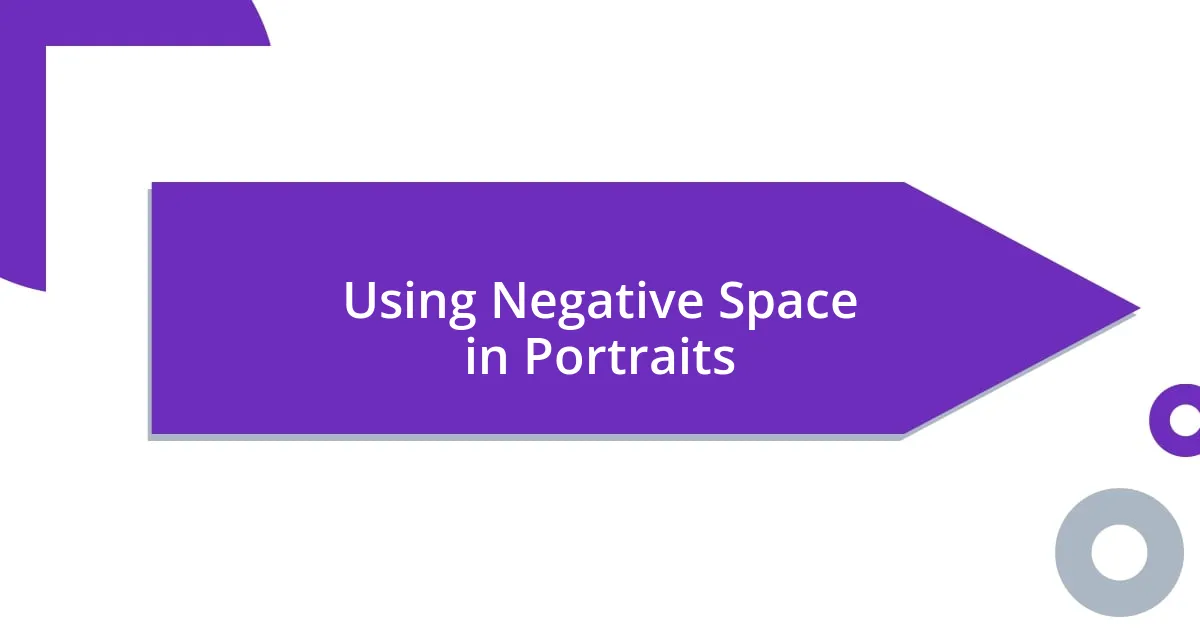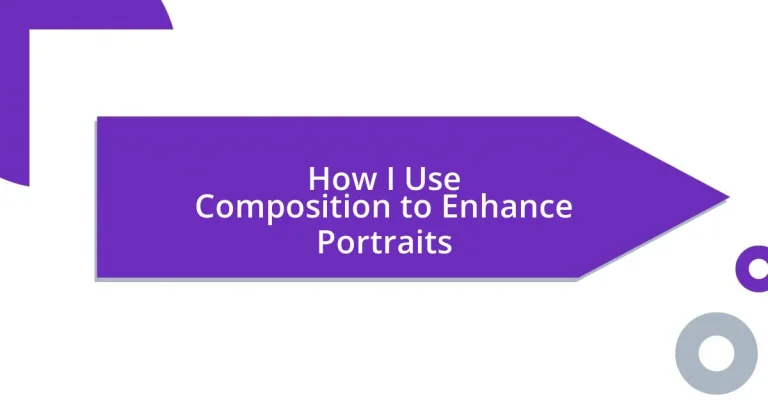Key takeaways:
- Effective composition in portraits enhances storytelling by guiding viewer focus and evoking emotions.
- Techniques like negative space and natural framing deepen the narrative and emotional connection in photographs.
- Adjusting perspectives, angles, and utilizing layers create depth and broaden the visual impact of portraits.

Understanding Composition Basics
Composition is the backbone of any great portrait, acting as a silent guide that draws the viewer’s eye to the subject. I often ask myself, “What is it about this frame that feels right?” When I pay attention to elements like rule of thirds or leading lines, I feel a real sense of connection to my subjects, which brings depth to the image.
One time, while photographing a close friend, I instinctively moved her slightly off-center in the frame. It created a dynamic space around her that told a story—it wasn’t just her face; it was the emotion in the empty room that surrounded her. This small adjustment made the final image resonate more deeply with both of us, adding layers to what might have been a straightforward shot.
Understanding composition basics is not just about adhering to rules; it’s about trusting your instincts. Have you ever looked at a photograph and felt an emotional tug? That’s the power of good composition—it can evoke feelings and tell stories, reshaping how we perceive the world around us.

Importance of Composition in Portraits
Composition in portraiture transcends mere aesthetics; it’s the heartbeat of storytelling. For instance, when I frame a subject, I often reflect on their expression and body language, pondering how best to enhance those elements. One of my favorite techniques is using negative space, which allows the viewer’s gaze to linger on the subject’s emotions while also inviting contemplation about their surroundings. This happened during a photoshoot where I captured a young artist in her studio, surrounded by her unoccupied easels. The emptiness conveyed her solitude and the weight of unfulfilled potential, transforming a simple portrait into a narrative.
Moreover, composition plays a crucial role in establishing context. By thoughtfully incorporating elements in the background, I can provide insight into the subject’s story and personality. I once photographed a musician in a bustling city, and rather than isolating him against a plain backdrop, I included the vibrant street life around him. The rhythmic chaos amplified his passion for music, creating an image that resonated deeply with viewers. This approach not only enhanced the portrait but also invited onlookers to engage with the broader story behind the person.
In every portrait, composition directly influences the emotional impact I aim to achieve. I always find that a well-composed portrait can ignite a sense of intimacy, as if the viewer shares a moment with the subject. I still recall shooting a grandmother with her grandchild, where my careful placement allowed their connection to shine through, capturing a fleeting moment of affection. This reinforces my belief that composition is not just a technical skill but a vital tool for emotional depth in portrait photography.
| Aspect | Impact on Portraits |
|---|---|
| Composition | Guides viewer’s focus, invokes emotions |
| Negative Space | Enhances subject’s narrative, adds emotional layers |
| Context | Provides insight into subject’s story, adds depth |
| Connection | Fosters intimacy between viewer and subject |

Techniques for Framing Portrait Subjects
Framing my portrait subjects effectively is such an exciting journey! There’s something magical about how different techniques can transform an image. One method I adore is using natural frames, like doorways or branches, to encapsulate my subject. I remember capturing a portrait of my sister standing in a sunlit archway. The arch framed her beautifully, emphasizing her bright smile and highlighting her joy. It felt as if I’d locked in a moment of happiness within those natural boundaries, making the photograph all the more meaningful.
Here are a few techniques that I frequently use to enhance my portrait compositions:
- Natural Frames: Use environmental elements like tree branches or windows to create a frame around your subject.
- Leading Lines: Incorporate lines in the background, such as paths or fences, that direct the viewer’s gaze toward the subject.
- Symmetry and Asymmetry: Balance your frame with symmetrical arrangements or intentionally off-center subjects to create visual interest.
- Layering: Place elements in the foreground to create depth, drawing the viewer into the portrait while adding context.
- Environment Integration: Include elements of the surroundings that speak to the subject’s personality or story, making the image resonate on a deeper level.
It’s fascinating how each technique can convey a distinct mood or story. The intentionality behind the way I frame my subjects truly transforms not just the visual impact, but also the emotional connection in each portrait.

Using Negative Space in Portraits
Using negative space in portraits is a game-changer for creating depth and narrative. I often find that leaving ample empty space around my subject allows the viewer to breathe in the emotions being conveyed. For instance, while photographing a contemplative writer sitting in a vast library, I deliberately captured her surrounded by towering, empty bookshelves. That minimalist background didn’t just highlight her solitude; it invited viewers to reflect on the stories waiting to be written, sparking a conversation between the subject and the audience.
Sometimes, I wonder how we can amplify a subject’s presence through spatial dynamics. In one memorable shoot, I positioned a dancer against a stark white wall, allowing her graceful movements to visually leap off the frame. The empty space surrounding her became a powerful contrast, emphasizing her fluidity and strength. That focus on her form made the viewer feel as if they were witnessing a fleeting moment of beauty, almost as if they were part of her world, which is the emotional connection I always strive for.
It’s remarkable how negative space can shift a portrait from being just an image to a full experience. I remember an enriching session with a young child playing in a field. I allowed the vastness of the sky to envelop them, emphasizing their smallness and wonder. The open space around that child not only highlights their innocence but also gives viewers a sense of freedom—the kind of refreshing feeling that sparks curiosity and invites imagination. It’s moments like these that reaffirm my belief in the transformative power of negative space within portraiture.

Adjusting Perspectives and Angles
Adjusting perspectives and angles can dramatically alter the mood of a portrait. I often play with the height at which I shoot, and I’ve found that a low angle can infuse an image with a sense of grandeur. Once, while photographing a tall friend in a vibrant urban setting, I knelt down to capture her looking towards the sky, which not only accentuated her height but also conveyed an inspiring sense of aspiration. It made me ponder how positioning can redefine narratives; what stories can emerge simply by shifting our viewpoint?
I also enjoy experimenting with angles by tilting the camera slightly. This technique, known as a Dutch angle, can evoke a sense of disorientation or dynamism. I remember a session with an artist showcasing her vibrant paintings in a bustling market. As I tilted my camera while focusing on her intense expression, the vibrancy of her art around her seemed to swirl with energy. It’s fascinating how the slightest turn can amplify a moment, leaving me wondering—how much can our perceptions shift just from a different angle?
Sometimes, the best angles aren’t the typical portrait setups. I recall capturing a shy musician, who preferred to hide in the shadows of the stage. By crouching to get a more intimate profile shot under subtle lighting, I revealed a vulnerability that conveyed his passion for music. The angle spoke volumes, drawing the viewer into his world of introspection and creativity. It’s a reminder that every slight adjustment we make can unveil deeper layers of our subjects—what stories are we missing when we stick to the conventional?

Creating Depth in Portrait Photography
Creating depth in portrait photography often relies on the interplay between foreground and background elements. One time, while shooting a portrait of my grandmother in her garden, I positioned some vibrant flowers in the foreground. This simple act added layers to the image, enhancing the story of her nurturing spirit and connection to nature. It made me reflect on how incorporating these elements not only builds depth but also invites the viewer to feel the warmth of that moment.
Lighting also plays a crucial role in creating depth. I vividly recall an evening shoot where I captured a friend against a setting sun. By positioning him so that the light source illuminated one side of his face, a three-dimensional quality emerged. The shadows created on the other side added intrigue, making it feel as though he was stepping out of the frame. This contrast piques interest—doesn’t it grab your attention and make you wonder what stories lie behind those shadows?
Another approach I love is to use layers. For instance, during a city street shoot, I framed my subject between two bustling café tables. This setup not only led the viewer’s eye deeper into the frame but also illustrated the vibrancy of urban life surrounding her. I think about how layers can create a narrative; when you see someone surrounded by action, how does that change your perception of them? It’s moments like this that encourage me to think outside the box and utilize every element around my subject to tell a richer story.














